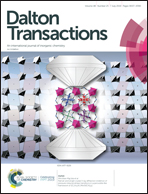A recyclable post-synthetically modified Al(iii) based metal–organic framework for fast and selective fluorogenic recognition of bilirubin in human biofluids†
Abstract
Herein, we report the fast and selective detection of bilirubin by a recyclable Al(III) based post-synthetically modified MIL-53 metal–organic framework (MOF) (1-NH2@THB). Post-synthetic modification was achieved by the aldimine condensation reaction between MIL-53-NH2 and 2,3,4-trihydroxy benzaldehyde. The post-synthetically modified compound was successfully characterized by Fourier transform infrared (FT-IR) spectroscopy, thermogravimetric (TG) analysis and X-ray powder diffraction (XRPD) experiments. The material has huge potential to detect bilirubin in HEPES buffer medium (pH = 7.4) by a fluorescence “turn-off” mechanism. The drastic quenching in the fluorescence emission intensity of the MOF material in the presence of bilirubin is due to the inner filter effect as well as molecular interactions between the MOF material and bilirubin. The probe displayed ultra-fast response (30 s), low detection limit (1.26 pM) and high selectivity towards bilirubin with the co-existence of several metal ions and biomolecules. Moreover, the real field application of the probe was thoroughly investigated in human bio-fluids (blood serum and urine samples) by the standard addition method. Furthermore, the quenching ability of the MOF material by bilirubin was also explored on a portable paper strip device. All the above discussions indicate that the probe is a potential candidate for the clinical detection of jaundice.



 Please wait while we load your content...
Please wait while we load your content...